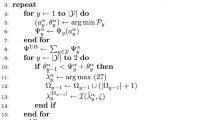Abstract
A nested Generalized Benders decomposition scheme is used to solve a mixed-integer stochastic programming model. The model evaluates central station and distributed power generation, storage, and demand management assets on a linearized electric power transmission network. It considers temporal and spatial variations in the marginal cost of power, which are captured in the Benders cuts in the solution scheme. These variations are caused not only by differences in generating unit operating expenses and capacity expansion costs, but also by physical transmission constraints that can alter minimum cost dispatch and siting of these units. The transmission constraints addressed include limits on MW power flows and both of Kirchhoff's laws via a linearized DC load flow representation. The model consists of three modules: a stochastic linear production costing model for operating central system generation, a nonlinear program for planning central system generation and transmission, and a mixed-integer program for evaluation of local area distributed resources. Generalized Benders decomposition is applied twice to coordinate these modules. The production costing model is a subproblem to the central system planning model, which is in turn a subproblem to the distributed resource model. The coordination scheme is described in detail, including the calculation of marginal costs. An application shows the effects of marginal cost variations on capacity expansion decisions.
Similar content being viewed by others
References
Benders, J.F. (1962). “Partitioning Procedures for Solving Mixed-Variables Programming Problems.” Numerische Mathematik 4, 238–252.
Billinton, R. and R.N. Allan. (1996). Reliability Evaluation of Power Systems. 2nd Ed. Plenum.
Billinton, R., R.J. Ringlee, and A.J. Wood. (1973). Power System Reliability Calculations. MIT Press.
Bloom, J.A. (1983). “Solving An Electrical Generation Capacity Expansion Planning Problem by Generalized Benders Decomposition.” Operations Research 31(1), 84–100.
Bloom, J.A. (1984). “Long-Range Generation Planning Using Generalized Benders' Decomposition: Implementation and Experience.” Operations Research 32(2), 190–313.
Feinstein, C.D., R. Orans, and S.W. Chapel. (1997). “The Distributed Utility: A New Electric Utility Planning and Pricing Paradigm.” Annual Review of Energy and the Environment 22, 155–185.
Geoffrion, A.M. (1972). “Generalized Benders Decomposition.” Journal of Optimization Theory and Applications 10(4), 237–260.
Gorenstin, B.G., N.M. Campodonico, J.P. Costa, and M.V.F. Pereira. (1993). “Power System Expansion Planning Under Uncertainty.” IEEE Transactions on Power Systems 8(1), 129–136.
Hobbs, B.F. (1995). “Models for Integrated Resource Planning by Electric Utilities.” European Journal of Operational Research 83(1), 1–20.
Hobbs, B.F. and Y. Ji. (1999). “Stochastic Programming-Based Bounding of Expected Production Costs for Multiarea Electric Power Systems.” Operations Research 47(6), 836–848.
Hogan, W.W. (1992). “Contract Networks for Electric-Power Transmission.” Journal of Regulatory Economics 4(6), 211–242.
Hoff, T.E. and M. Cheney. (2000). “The Potential Market for Photovoltaics and Other Distributed Resources in Rural Electric Cooperatives.” Energy Journal 21(3), 113–127.
Hoff, T.E., H.J. Wenger, and K.K. Farmer. (1996). “Distributed Generation: An Alternative to Electric Utility Investments in System Capacity.” Energy Policy 24(2), 137–147.
Huang, W. and B.F. Hobbs. (1994). “Optimal SO2 Compliance Planning Using Probabilistic Production Costing and Generalized Benders Decomposition.” IEEE Transactions on Power Systems 9(1), 174–180.
Jenkins, N., R. Allan, P. Crossley, D. Kirschen, and G. Strubac. (2000).” Embedded Generation. Institute of Electrical Engineers, London, U.K.
Kahn, E.P. (1995). “Regulation By Simulation: The Role of Production Cost Models in Electricity Pricing and Planning.” Operations Research 43, 388–398.
Lee, F. (1990). “Multi-Area Power System Reliability and Production Costing.” EPRI EL-6912, Electric Power Research Institute, Palo Alto, CA.
Leppitsch, M.J. and B.F. Hobbs. (1996). “The Effect of NOx Regulations on Emissions Dispatch: A Probabilistic Production Costing Analysis.” IEEE Transactions on Power Systems 11(4), 1711–1716.
McCusker, S.A. (1999). “A Benders Decomposition Approach to Multiarea Stochastic Distributed Utility Planning.” Ph.D. Thesis, Department of Geography and Environmental Engineering, Johns Hopkins University, Baltimore, MD.
McCusker, S.A., B.F. Hobbs, and Y. Ji. (2002). “Distributed Utility Planning Using Probabilistic Production Costing and Generalized Benders Decomposition.” IEEE Trans. on Power Systems 17(4), 497–505.
Moore, T. (1998). “Emerging Markets for Distributed Resources.” EPRI Journal 23(2), 8–17.
Noonan, F. and R.J. Giglio. (1977). “Planning Electric Power Generation: A Nonlinear Mixed Integer Model Employing Benders Decomposition.” Management Science 23(9), 946–956.
Perreira, M.V.F. and L.M.V.G. Pinto. (1985). “Stochastic Optimization of a Multireservoir Hydroelectric System: A Decomposition Approach.” Water Resources Research 21(6), 779–792.
Pfeifenberger, J.P., P.Q. Hanser, and P. Ammann. (1997). “What's in the Cards for Distributed Resources?” The Energy Journal, Special Issue on Distributed Resources 1–16.
Pupp, R.L. et al. (1996). “Distributed Utility Penetration Study. Electric Power Research Institute (EPRI) TR 106265, Research Project 3733-03, Final Report, Palo Alto, CA.
Pupp, R.L., R. Orans, C. Feinstein, K. Lau, and J. Grainger. (July 1993). “Distributed Utility Valuation Project Monograph. Electric Power Research Institute (EPRI) TR 102807, Palo Alto, CA.
Rau, N.S. and Y.H. Wan. (1994). “Optimum Location of Resources in Distributed Planning.” IEEE Transactions on Power Systems 9(4), 2014–2020.
Schweppe, F.C., M.C. Caramanis, R.D. Tabors, and R.E. Bohn. (1988). “Spot Pricing of Electricity. Boston: Kluwer.
Turvey, R. and D. Anderson. (1977). “Electricity Economics: Essays and Case Studies. University, Baltimore, MA: The Johns Hopkins
Wood, A.J. and B.F. Wollenberg. (1996).” Power Generation, Operation and Control. 2nd Ed. New York: Wiley.
Author information
Authors and Affiliations
Rights and permissions
About this article
Cite this article
McCusker, S., Hobbs, B.F. A Nested Benders Decomposition Approach to Locating Distributed Generation in a Multiarea Power System. Networks and Spatial Economics 3, 197–223 (2003). https://doi.org/10.1023/A:1023912019269
Issue Date:
DOI: https://doi.org/10.1023/A:1023912019269




